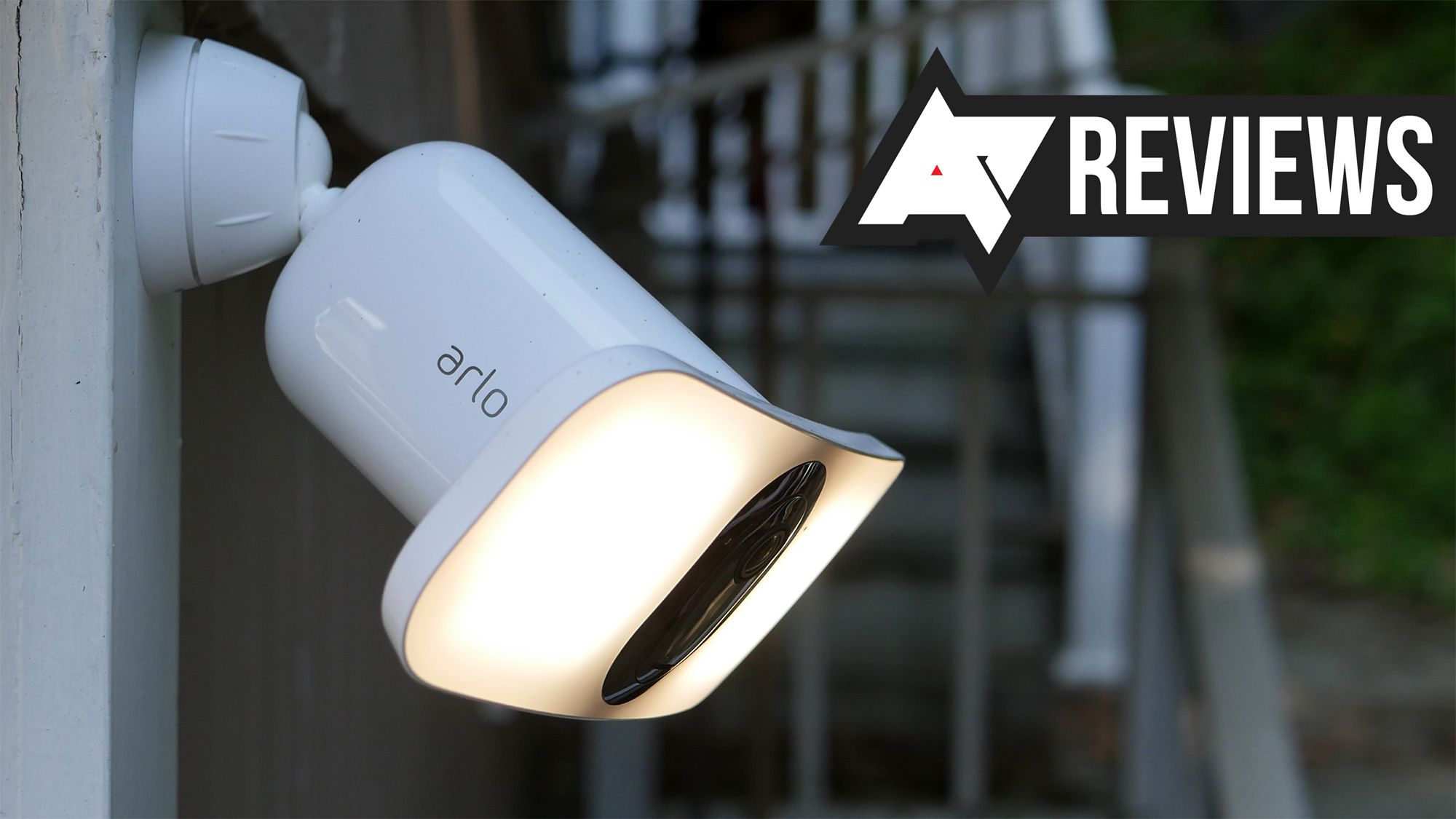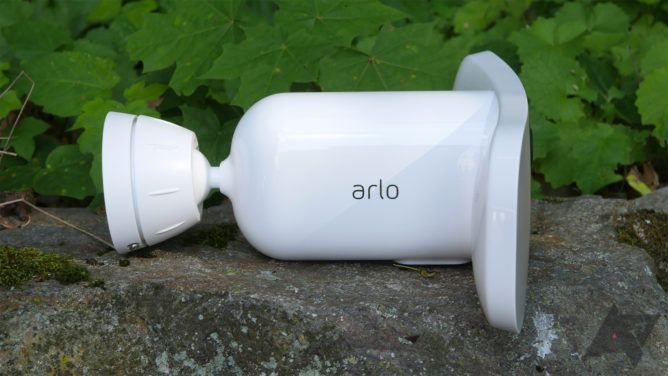Quick Links
For all of the genuinely useful smart-home products Arlo offers, sometimes it feels like the company's got a bit of a blind spot when it comes to combining them. Cameras have always been its bread and butter, but when Arlo introduced its first doorbell in 2018, it was audio-only — we'd have to wait another year for the Video Doorbell. And while Arlo's had its wireless Smart Light for years, it's only now that the company is taking one of its lauded cameras and integrating it with an extra-bright exterior light: the Arlo Pro 3 Floodlight.
SPECS
|
Camera |
2560 x 1440 2K-class |
|
Field of view |
160 degrees diagonal |
|
Night vision |
2x IR LEDs for B&W, 2000-3000 lumen white LED floodlight |
|
Audio |
Microphone with noise and echo cancellation |
|
Power |
47.19 Wh battery |
|
Connectivity |
802.11 b/g/n, optional hub |
|
Local storage |
None on-camera, only available with optional hub |
|
Cloud storage |
None free, available as paid add-on (/mo) |
THE GOOD
|
Brightness |
Arlo warns you not to look directly into this thing, and it ain't kidding. |
|
Robust mounting |
Weighing more than two Pro 3s, and with a light that's basically a big wind-catching sail, I still feel comfortable thanks to some key mounting hardware upgrades. |
|
Assistant integration |
Not only can you view your video stream on Assistant devices, but the floodlight itself shows up as a standard smart bulb. |
|
Value |
Considering a regular Pro 3 add-on cam goes for $200 (and still needs a hub), upgrading to the floodlight for just $50 more seems like a bargain. |
THE NOT SO GOOD
|
Arlo Smart |
Delivering object recognition as software-as-a-service and killing off free 7-day cloud recording makes a Smart subscription practically mandatory. |
|
Aiming |
Between the sheer mass of this thing and the very tacky ball-and-socket mount, it can be hard to get exactly the right angle you're looking for. |
Design, hardware, what's in the box
For the Pro 3 Floodlight, Arlo basically took one of its Pro 3 cameras (obviously), extended the body length to accommodate a larger battery, and attached a panel that almost looks like a pair of wings to the front to house the floodlight LEDs and their diffuser. The camera face itself is largely unchanged from the Pro 3, dropping only its two (comparatively tiny) illumination LEDs in favor of this much more powerful panel.
Even elongated and with that big floodlight panel, it's impossible to ignore the Pro 3 roots.
The floodlight bit is permanently attached to the front of the camera, and together they slide out of the weather-resistant housing. The main difference here, compared to contemporary Arlo cameras, is that there's no magnetic mounting option, and the shell is permanently attached to its ball-and-socket mount.
That means that instead of pulling the whole assembly down to recharge, you instead depress the release button on the shell's bottom to eject the camera innards. On the side you'll find a micro-USB (what year is this?) charging port that's inaccessible when the camera's mounted. While the shell does include the same sort of proprietary magnetic charging port we saw on the Pro 3, there's no matching cable included, and its presence here is intended for use with an optional outdoor power cable.
The Floodlight's battery dwarfs the old Pro 3's (left), accessing the charging port (right)
Arlo upgrades the battery from an 18.48Wh component on the Pro 3 to a new 47.19Wh unit offering over twice the capacity. Obviously that extra juice is here to help power the floodlight, but the user has a lot of say into just how far that power will go. I've been operating the system for just over two weeks now, and I'm looking at about 85% battery remaining, so I'm pulling about 1% a day and can expect to recharge in a few months. Output is limited to 2000 lumens on battery power, but adding that outdoor power cable increases your max to 3000 lumens.
All told, you'll find the Pro 3 Floodlight itself boxed with its battery, shell and mounting hardware, micro USB cable and charger, safety notice, and a window sticker to alert visitors of the camera's presence.
Setup and installation
The original Pro 3 weighed just 316g; the Pro 3 Floodlight tips the scales at 650g, over twice as much. As a result, the mounting hardware this time around is much hardier, rejecting any type of magnetic mount in favor of a strong, physical connection. You get started by using the included wall plate as a template to mark off and drill holes for your mounting screws. I'd feel a little better if the plate itself were metal, as it's taking a lot of force here, but so far the plastic one Arlo uses has held up.
Three screws secure the mounting plate (left), a twist locks the shell at the right angle (right)
With that in place, you can twist the ball-and-socket mount of the Pro 3 Floodlight's shell onto the wall plate, turning one more screw to secure it fast. Arlo smartly advises users to do all this with the camera guts removed, making the hardware much easier (and lighter) to work with. To aim the unit you'll loosen the socket with a twist, point it where it needs to go, and twist back tight. The material within this joint is quite tacky, helping it maintain your chosen angle even under the camera's load, but as a consequence is also a little difficult to work with — luckily you should only have to bother with this once.
Each step of the installation process is helpfully illustrated.
On the software side, the Arlo app seamlessly guides you through this whole process with a lot of helpful illustrations. If you have an existing Arlo SmartHub, you can connect to it here, though unlike the majority of Arlo cameras, the Pro 3 Floodlight can run directly on your 2.4GHz Wi-Fi network with no additional hardware. If you do own a SmartHub, though, I really suggest you use it, as that's the only way to store your recordings locally, and Arlo advises that you'll see better bandwidth compared to operating over Wi-Fi.
Throughout all this, the only real hiccup I faced was in getting the camera to scan a QR code from the app during configuration. Then again, this is far from the first camera to struggle there.
Video and app features
Seeing as the Pro 3 Floodlight is at its core a Pro 3, I already knew a lot of what to expect from its camera performance and video output. We're talking the same 2K resolution, same 160-degree wide-angle lens, and same support for features like Arlo Smart's object recognition or subject auto-tracking. I highly suggest you take a look at my findings with the Pro 3, as the Floodlight changes practically none of that — daytime footage is crisp and largely smooth, and while all this extra light risks overexposure at night (and hurting contrast in the process) that slight hit to quality is easily balanced out by the ability to see everything lit up in full color.
Get ready to meet a whole cast of critters, showing up on camera at all hours.
Sometimes the bright floodlight does wash subjects out a bit.
Daytime video quality is great, but not without the odd glitch-out.
What you will find beyond the base Pro 3 experience are some new options here for you to control. You're able to adjust the ambient daylight level at which the floodlight turns on, ensuring you're not wasting the battery when it's not needed, as well as adjust output brightness; I've been happy staying around the 75% mark.
Viewing the camera's feed in the Arlo app and adjusting settings.
Independent of camera operation, you can also use the floodlight as ... well, a floodlight. Your main device screen in the Arlo app displays a toggle for turning the light on and off, and gives you a convenient brightness slider to save you from diving into settings each time you want to change it. The floodlight can be run in constant or blinking operation, and you can set an auto time-out from 1 to 20 minutes.
Accessing the Arlo Pro 3 Floodlight in Google Home.
Like other Arlo cameras, there's Google Assistant integration here, and it works pretty well. You'll see the Pro 3 Floodlight appear in your Home devices twice: as both a camera and a bulb. That means you can not just watch your feed on Assistant displays, but also control the floodlight like any other smart bulb. I wasn't quite expecting that smart-bulb operation out of the box, but it's proven to be surprisingly useful.
Of course, Google's isn't the only smart-home framework out there, and Alro also includes support for Alexa and Apple HomeKit.
Should you buy it? Rating 8.5/10
Arlo Pro 3 Floodlight
Yes. When the Pro 3 came out, I was sore about losing the Pro 2's free cloud recording, and locking so many features behind the subscription Arlo Smart service — while nothing's changed there for the Pro 3 Floodlight, I've mostly grown to accept the Arlo business model for what it is. That position's helped a little by this model's ability to function without a hub, decreasing initial costs.
Aside from all that, I really liked the Pro 3's hardware, and the Floodlight just makes a good thing better. Video quality still looks great in 2K, and now you can see a whole lot more at night, as well. Nighttime footage can be a little overexposed if subjects get too close to the camera, and like all Arlo units there's the occasional video glitch, but nothing that really sours me towards the unit.
The value proposition here is strong, and at $250 the Floodlight costs only $50 more than a Pro 3 cam. Even if you don't end up finding the floodlight bit super useful, you can always dial that down and take more and more advantage of the giant battery Arlo's hooked the unit up with. Sure, it's kind of weird-looking, and is a little heavier than I'd like from a wall-mounted camera, but there's no denying this is a well-executed device that would be a great addition to your smart home.


